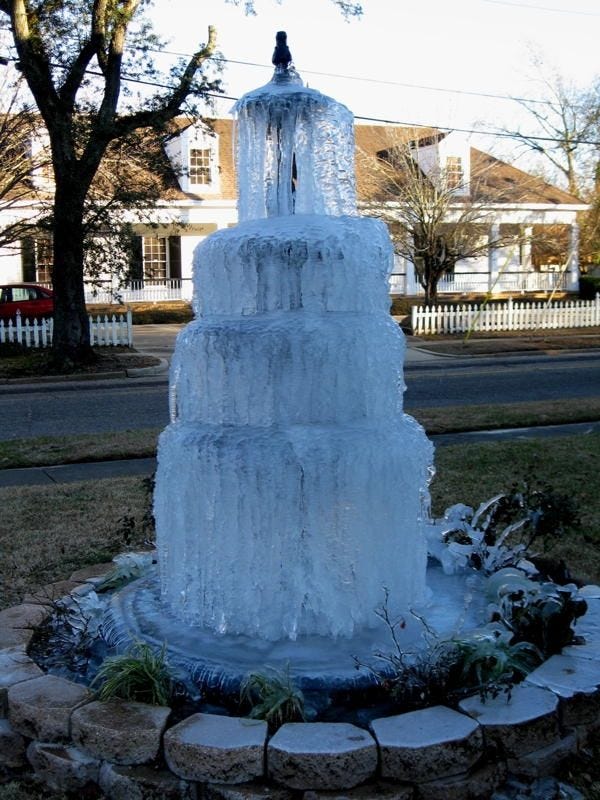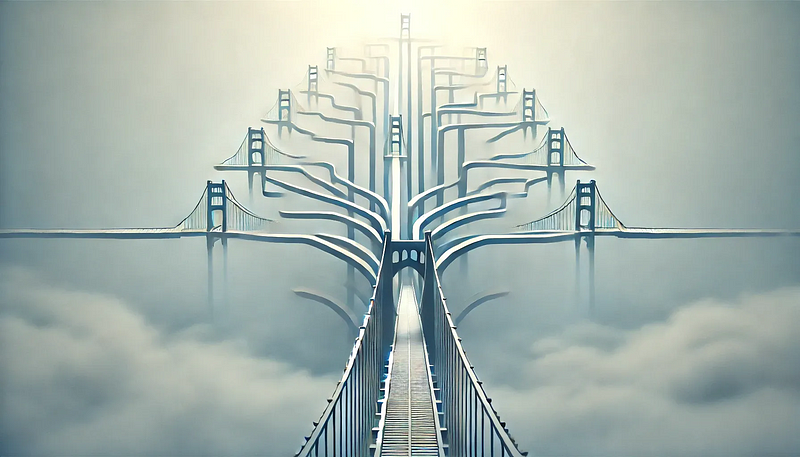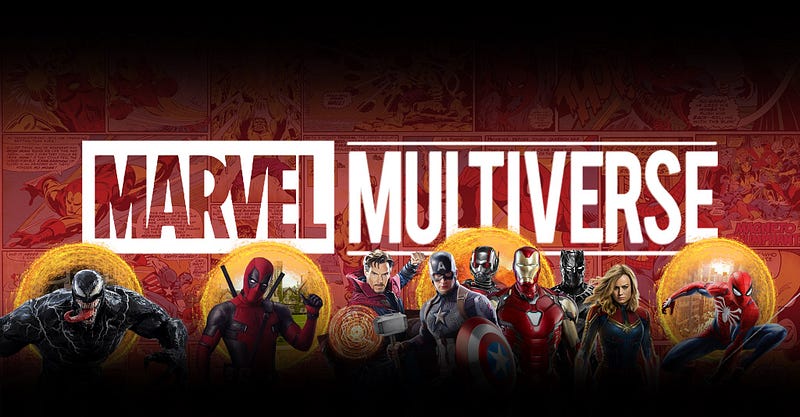
Alice and Bob were soaking the winter sun in front of a water fountain. Alice was in a merry mood and warmly recollected their previous adventures in Quantum Land.
“Isn’t it so crazy that every time we are not looking, quantum particles keep flowing everywhere like waves… just like this flowing water. But they all become solid as soon as we steal a glance! It is like water instantly freezing.”
Bob nodded, leaning back thoughtfully. “Indeed. At the quantum scale, the particles are so tiny that we cannot actually see them without light bouncing off and affecting them in some way.”
Alice added, “It is like kicking in a dark room with soccer balls lying around. The only way you know there is a soccer ball nearby is when you have already hit one. But by then, you have already hit it and changed its state.”
Bob grinned, clearly impressed. “That is a brilliant way of seeing it, Alice!”
Alice grew more thoughtful, her gaze fixed on the fountain. “But I still cannot stop thinking about what would have happened if the quantum ball was not kicked. Would it have continued secretly playing with the others, without us knowing?”
As if on cue, the train to Quantum Land materialized out of thin air and beckoned them to their next adventure.
The Bridge To Possibilities
Alice and Bob stepped off the train and into what looked like a misty dream. Gone was the familiar sandy or rocky desert. This time, they found themselves standing at the end of a vast bridge suspended over an endless abyss. The bridge was unlike anything they had encountered in Quantum Land so far — its surface rippled like liquid but felt solid underfoot. As they stepped onto it, they noticed something even stranger: the bridge seemed to split into countless paths as they proceeded.
The glowing paths branched out like the roots of a tree, twisting, looping, and reconnecting in ways that defied logic. Some trails faded into the distance, while others curved back on themselves, creating a mesmerizing web of possibilities.
Alice stopped in her tracks, staring at the intricate network. “Bob,” she said slowly, “this bridge cannot seem to make up its mind. Every step leads to a dozen different paths! How does anything ever go anywhere in this place?”
Bob squinted, clearly as intrigued as she was. “It looks like it is exploring every possible option at once,” he said, his voice tinged with wonder.
Alice tilted her head, her practical instincts kicking in. “Wait. Are you saying it is like trying out every route before deciding which one to take? That does not make sense! You can only choose one path at a time.”
Bob scratched his chin, thinking. “In the classical world, sure. But in Quantum Land, things do not work that way. What if I told you that a particle does not take just one path to get from any point A to any point B? Instead, it explores all possible paths simultaneously.”
Alice raised an eyebrow. “All possible paths? That sounds ridiculous! How can something take every path at once?”
Bob shrugged, a small smile at the corner of his lips. “That is another way of life in the quantum limit. Particles in Quantum Land do not follow just one route — they take every possible path. And the way these paths combine, overlap, or cancel out determines where the particle ends up.”
Alice frowned, clearly unconvinced. “You mean that if a soccer ball was in Quantum Land, it would bounce around everywhere before it actually lands anywhere? I cannot even visualize that!”
Just as she said that, a soccer ball appeared at her feet. “Go ahead, there is your quantum soccer ball now,” Bob chuckled.

Alice’s Soccer Strategy: How Particles Choose the Path
Alice placed her soccer ball on the shimmering bridge, her go-to method for testing Quantum Land’s peculiarities. She nudged it forward with her foot, watching closely as the ball began to roll. To her astonishment, the ball did not follow a single trajectory. Instead, it split into dozens of glowing trails, each representing a possible path. Some trails twisted into spirals, others zigzagged wildly, and a few curved gently before fading into the distance.
“Did you see that?” Alice exclaimed, pointing to the glowing trails. “The ball is literally trying out every possible move, all at once!”
Bob crouched beside her, equally intrigued. “Each of these glowing trails represents a path the ball might take. But notice how some paths glow brighter than others?”
Alice leaned closer, her curiosity piqued. “Yeah. It is like some paths are more ‘confident,’ while the others are fading into the background.”
Bob nodded. “That is interference at work. The brighter paths are the ones that reinforce each other, amplifying their likelihood. The dimmer ones cancel each other out and become less significant.”
Alice’s eyes lit up as she made a connection. “Oh, so it is like a soccer team! When players coordinate and pass the ball strategically, they are more likely to score. But if they are disorganized and running into each other, they waste energy and get nowhere.”
Bob chuckled. “Exactly. In Quantum Land, every path contributes to the particle’s journey, but only the coordinated ones — the ones that reinforce — really matter in the end.”
Alice gave the ball another small kick, watching the glowing trails shift and swirl again. “So, the particle is like a player trying out every possible strategy at once, but only the strongest gameplay — the ones with the best teamwork — determine the final goal.”
Bob smiled. “That is the essence of what physicists call the Feynman path integral. It is how particles navigate Quantum Land: every path matters, but not all paths are created equal.”

What We Actually See: The Expectation Value
Alice nudged the ball again, watching the trails shift and swirl as it moved. She leaned on the bridge railing, her brow furrowed. “Okay, so we have all these glowing trails, right? But in the end, we only see the ball take one path. It feels like the rest of the possibilities just vanish. How does that work?”
Bob adjusted his glasses, thinking. “Well, the glowing trails do not represent actual paths the ball takes. Instead, they show the probabilities of where the ball might end up. When we observe the ball — like looking at the result of a soccer play — those probabilities collapse into one outcome.”
Alice frowned, still trying to visualize it. “Wait, so you are saying the ball does not choose a path, but the act of observing forces it to show us just one?”
“That is right,” Bob replied. “The glowing trails represent the possibilities, not the actual paths. When we see the ball in a specific place, it is not because it ‘settled’ on that path — it is just the outcome of how those probabilities play out in that moment.”
Alice frowned, still trying to visualize it. She pointed to one of the brighter trails. “Okay, let us say the ball was already rolling toward the goalpost. That bright trail must mean it is more likely to reach the goal, right?”
Bob nodded. “You could think of it that way. If we repeated this experiment a hundred times with the ball starting in the same position, most of the time it would follow that brighter path and score. But there would still be a few matches where it gets intercepted or veers off course.”
Alice gestured toward the dimmer trails. “And those fainter ones — are they the plays where it gets deflected or kicked away?”
“Precisely,” Bob said, stepping beside her. “Those dim paths represent the less likely outcomes. The brightness of the trails shows how much they contribute to what we expect to see in the long run.”
Alice leaned on the railing, her mind racing. “So, if we repeated the same game over and over, we would not get the same exact result every time. But over enough games, we could figure out the average result — the most likely outcome?”
Bob smiled. “That is a great way to put it. That average — or what we expect to see over many repetitions — is what physicists call the expectation value. It is not about predicting one specific outcome, but about understanding the overall pattern.”
Changing the Reality: Just Like Marvel’s Multiverse
Alice nudged the ball again, her curiosity now mixing with excitement. “Wait a second!” she said suddenly. “This reminds me of Marvel’s multiverse stories! You know, like in Doctor Strange or Loki. When one tiny decision changes, everything ripples outward.”
Bob raised an eyebrow, intrigued. “Go on.”
Alice continued enthusiastically, “Remember how Loki took the Tesseract and created a completely different timeline? Or how Doctor Strange kept tweaking events in Multiverse of Madness? The entire story shifts based on one small change. It is not that the other timelines disappear — they are still out there — but the focus changes to the new branch.”
Bob nodded, clearly impressed. “That is a fantastic analogy, Alice. Quantum interference works the same way. All possibilities exist, but when we tweak something — like blocking one of these paths — the probabilities shift, and the final outcome is completely rewritten.”
Alice grinned, kicking the ball deliberately toward one of the dimmer paths to block it. Instantly, the remaining trails adjusted, with some becoming brighter and others fading away. “See? Just blocking this faint path changes the whole story. It is like being Loki and Doctor Strange combined — the master of chaos and storytelling!”
Bob laughed. “Exactly. But in Quantum Land, every adjustment is like rewriting a narrative. The possibilities shift, the interference patterns change, and what we see in the end is shaped by all these little tweaks.”
They both gazed at the swirling trails of the soccer ball, now glowing like threads of possibility. Their laughter echoed across the shimmering bridge, which seemed to respond by rippling gently under their feet. They didn’t know how long they continued comparing the Marvel Universe with Quantum Land until they heard the whistle of the train to bring them back to the Classical World.

References:
“QED: The Strange Theory of Light and Matter” by Richard Feynman — Explains the quantum world for a general audience.
“Six Easy Pieces” by Richard Feynman — A classic introduction to fundamental physics concepts, including quantum mechanics, by one of the most celebrated physicists of all time.
Feynman Path Integral: Richard Feynman, “Quantum Mechanics and Path Integrals (1965)” — This foundational text introduces the path integral formulation of quantum mechanics in detail.
Double-Slit Experiment: “The Elegant Universe” by Brian Greene —
This book introduces quantum mechanics and its key experiments, including the double-slit experiment.Expectation Value: “Introduction to Quantum Mechanics” by David J. Griffiths — Offers a clear and technical explanation of expectation values in quantum mechanics.
I hope you enjoyed exploring Quantum Land with Alice and Bob! What adventures should they embark on next? Share your ideas or questions — I would love to hear from you. Connect with me on LinkedIn or follow me here on Medium for more stories about science, curiosity, and the fascinating world of quantum physics.
#Quantum #YearOfQuantum #IYQ25 #StayCurious #Quriosity #QuantumLand

